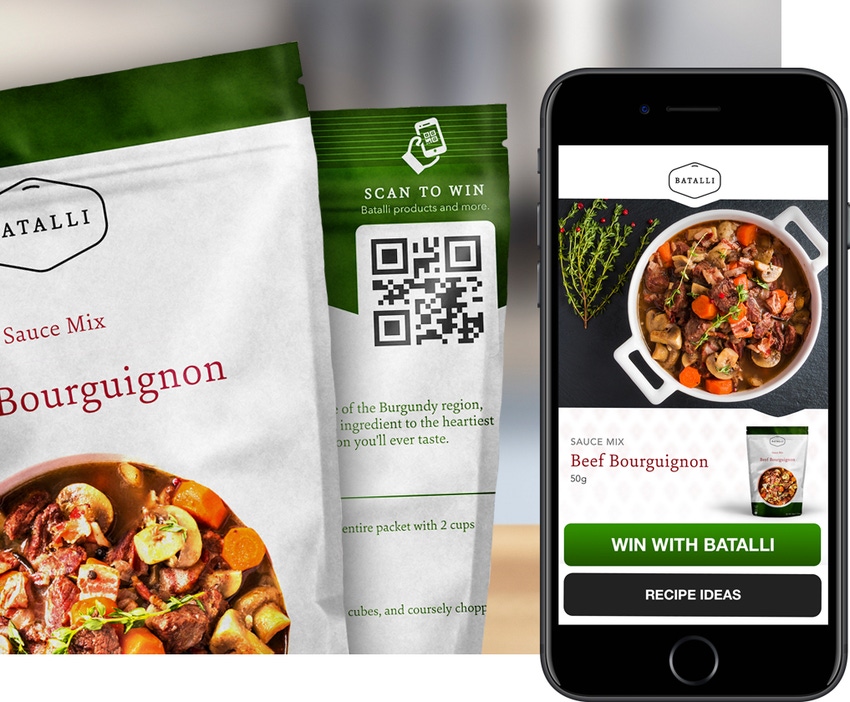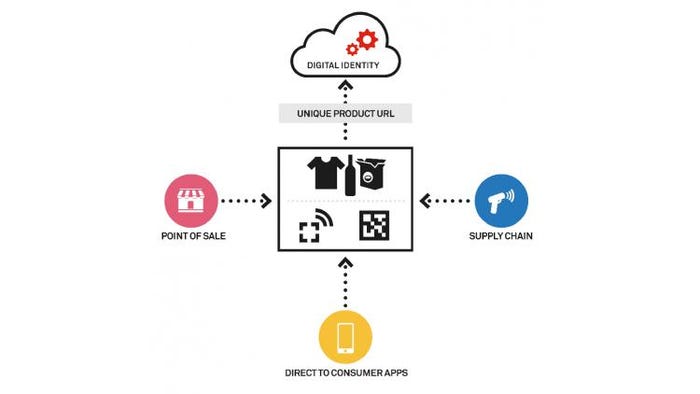Smart barcodes let brands easily join the internet of (packaged) things

Smart packaging took a step forward recently with the availability of a software tool that enables brand owners to create digital identities for their products using the existing GS1 identifiers in universal product codes (UPCs), thus web enabling any product with a UPC. It also allows brands to insert those same GS1 identifiers into other codes, including Quick Response (QR) codes and near-field communication (NFC) tags. This creates a standardized data format that is understood by all systems and readers in a product’s lifecycle.
This approach to coding promises simplified packaging design—by eventually eliminating multiple on-pack codes—while driving smartphone interactions between consumers and brands. Each product with a smart barcode has a web address, and by scanning the code, consumers can access information about the product and brand owner.
At the center of the development is the EVRYTHNG QuickStart Online Tool. Andy Perrin, EVRYTHNG’s product marketing director, explains, “The significant change is the ability for any on-product code to be able to trigger a web address and thus make the product web-enabled. This is made possible by the GS1 URI [Uniform Resource Identifier], which enables a QR code to be scannable by smartphones to deliver a digital experience or information associated with that unique item and also by a point-of-sale system to extract the GS1 identifier and hence the price.”
EVRYTHING’s packaging-industry partners include Avery Dennison Retail Branding & Information Solutions, for footwear and apparel brands and retailers; Westrock, for paperboard-packaged products in the food, beverage and home-goods markets; and Crown, for cans and other metal packaging used with beverages and other consumer products.
Ryan McManus, svp partnerships and corporate development at EVRYTHNG, is scheduled to speak at EastPack 2018 on Tues., June 12, from 3:00 to 3:45 pm, to answer the question "What Can Brands Do With an Internet-Enabled UPC?" His presentation is part of a full agenda of free packaging-related sessions taking place on the show floor at the Packaging Hub during the three-day event. Click here to register now to attend.
For now, Niall Murphy, CEO and founder of EVRYTHNG, tackles some questions about the technology, which interfaces with the existing UPC format managed by GS1.
Why did it take so long to enable UPCs for direct-to-consumer communication via smartphones?
Murphy: Two things needed to happen:
One, the code on a product containing the UPC (GS1 GTIN) needed to be in a web-address form, so smartphones would be able to read the web address and connect to the web to access applications linked to that product. But the same web-address format needed to be understandable by point-of-sale and supply-chain systems. A GS1 URI (Uniform Resource Identifier) provides this, giving a standardized data format to include both the GS1 product identifiers for offline “reading” and a dynamic web address that can launch an application or provide product or brand content. This means GS1 identifiers can be encoded in QR [quick response] codes or NFC [near-field communication] tags.
Two, smartphones needed to be able to automatically read codes. Recent updates to iOS and Android mean that more than 2 billion smartphones can now natively scan QR codes and NFC tags.
What’s the value of this technology to brands and consumers?
Murphy: Brands or retailers can launch direct-to-consumer applications to enhance the shopper experience and build loyalty after the sale, and at the same time collect consent-based, first-party data to inform marketing and product-development strategies.
Consumers in-store can access brand content and product information (such as provenance, manufacturing, sustainability, nutrition and care instructions), as well as recommendations and product comparisons, and perform self-checkout. Post-purchase, consumers can scan the product for friction-free reordering, registration or rewards and offers.
The content and experiences can be personalized, contextual and real-time, which increase the value of a digitized product to both brand and consumer.
Who will handle the digital database for web-enabled products?
Murphy: GS1, as a neutral standards body, will continue to maintain and issue GS1 identifiers. But, with the URI format, brands can connect their physical product to a product web address—an intelligent identity for that product in the cloud. The data from and about the product can be actively managed, and any action/interaction taking place with that product’s web address can be responded to intelligently. Examples include authenticating a product, tracking its location in the supply chain, delivering personalized experiences or facilitating mobile payments.
How can brands and retailers enable this functionality?
Murphy: Brands and retailers need to put digital codes onto their products that use GS1 identities and link that to digital applications on the web. Companies can get started easily, delivering digital applications via the web in minutes with the free service EVRYTHNG provides. There are three steps:
1. Sign up for a free account with the EVRYTHNG platform at www.evrythng.com/gs1.
2. Enter existing GS1 identifiers to automatically create digital identities for the products.
3. Choose from a selection of template consumer experiences or create custom experiences.
How much will this functionality cost brand owners and retailers?
Murphy: The EVRYTHNG “starter” package is free and provides unlimited digital identities in the cloud. We provide more advanced functionality on a fee basis, supporting Blockchain integration, machine learning and custom analytics to deliver sophisticated direct-to-consumer application experiences and to operate supply-chain analytics and integrity-management applications.
From a packaging and labeling perspective, a single, standard code printed on a product is able to serve multiple applications and therefore provide global economies of scale in production costs and efficiency in on-product space utilization.
What are the benefits to the brand?
Murphy: In the short term, it will mean brands can avoid using proprietary or one-off codes from the likes of Shazam and Snapchat and instead use an “always-on” QR code and/or NFC tag that gives permanent web connectivity and the ability to provide location- or context-specific services that can be updated at any time.
This will reduce the complexity and cost of packaging design and give greater flexibility to offer new services without the need to update packaging.
Strategically, brands can not only gain a valuable one-to-one connection to the consumer but also benefit from better insights into their operations by capturing data throughout the product lifecycle, helping detect issues such as gray-market sales or counterfeiting and giving visibility beyond point of sale.
How will brands communicate this new functionality to consumers?
Murphy: Brands need to provide a call to action on their product to tell consumers there are digital services or applications linked to the product. In addition, they should communicate the benefits of what is available from product interaction through other communication channels. A QR code or NFC tag will sit alongside the existing 1D barcode for a period of time. This is to ensure the ability to work with legacy point-of-sale systems unable to support the new coding.
How long is a “period of time” before the UPC is the only web-enabled code needed to connect a consumer to the Internet of Things?
Andy Perrin answers: We expect an interim period where UPC codes remain on packaging, and QR codes and/or NFC tags are added, in preference for other proprietary codes which have found their way onto packaging. Once the new standard is ratified, and point of sale and supply chain systems get updated to recognize QR codes, we expect strong industry pressure for a single code on all products. Or in the words of GS1: “where a single 2D barcode could serve the needs of all parties.”

Which brand owners and retailers have committed to this already?
Murphy: Leading New York-based fashion brand Rebecca Minkoff uses EVRYTHNG to deliver direct-to-consumer experiences through its range of digitally enabled apparel and accessories. We are rolling out pilots of the new format in the coming weeks and are also actively working with existing brands and packaging companies to implement a GS1 URI format.
*******************************************************************************
Production efficiencies, ecommerce challenges, sustainability trends, new bioplastic technologies and more are among the topics on the agenda at the new Packaging Hub at EastPack 2018. This free educational program will have more than 16 hours of can’t-miss presentations and demonstrations. Register to attend today!
About the Author(s)
You May Also Like




